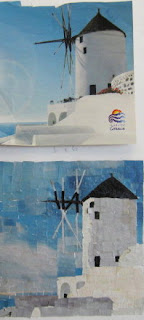Today's Class- Although we dealt with a few aspects of it last week, today we began color for real, exercises related to color theory. I talked about the scientific nature of color, sources of color for art purposes, and then showed a few dozen slides related to the history of color in art, both painting and sculpture. Then on to the exercises. We used watercolor to make a 12 hue color wheel, and do an exercise in complementary color mixing.
How to make this up- Below is an example of the kind of thing we did today. Everyone completed a color wheel, using primary, secondary, and intermediate colors. The second part was selecting a pair of complementary colors and an exercise that involved mixes and tints of those colors.
Detailed instructions and another student example can be found here.
Homework- No new homework. However, we are about to enter March, so keep in mind the museum assignment will be due in a few weeks.
For next class 3/2/18- Next week's topic is photography, and we'll be looking at many examples of the history and uses of photography over the past few centuries. The exercise will be something you take home to work on, so you don't need any art materials for next week's class. I will distribute the assignment in class next week. I will use a chunk of the remaining time to take us on a tour of the building, as many of the studio classrooms as are open, and perhaps the student show in the gallery downstairs as well.







